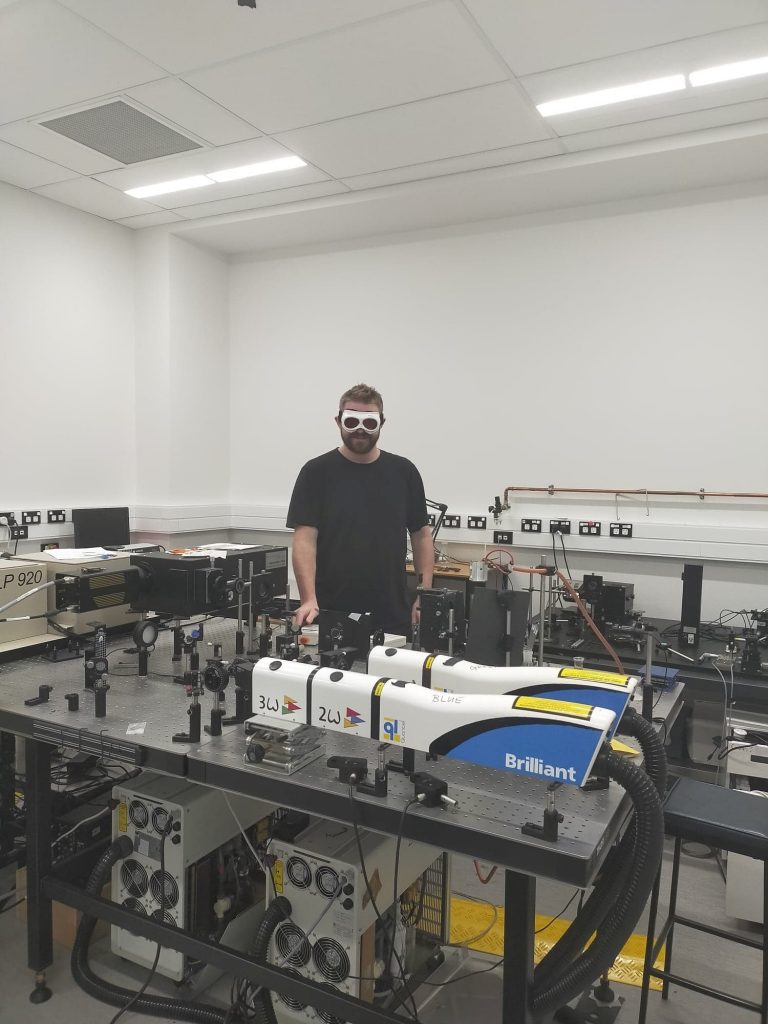My research focuses on developing an understanding of the excited state dynamics of a range of molecules. Excited state nature is a critical factor in the efficacy of several applications including solar cells, organic light emitting diodes and photocatalysts. I use a range of spectroscopic techniques in concert with calculations to investigate how changes to a molecular structure affects its excited state lifetime, energy and location.
Resonance Raman spectroscopy aids in the characterization of electronic transitions and thus the nature of the initially populated excited state. When an excitation wavelength coincident with an electronic absorbance is used an enhancement is observed of specific vibrational bands that mimic the change in electron density that occurs for that transition. Several emission measurements allow for the relaxed excited state properties to be described. Transient techniques (absorption, emission and Raman) provide further insight into how the excited states of a molecule behave. These experimental techniques help corroborate predictions made by density functional theory calculations.
Education:
2017 BSc.(Hons.) Chemistry – University of Otago (First Class)
2016 DipGrad Chemistry – University of Otago
2011 BSc. Biochemistry – University of Otago
Publications:
1. Mapley, J. I., Hayes, P., Officer, D. L., Wagner, P., & Gordon, K. C. (2020). Investigation of Ferrocene Linkers in β-Substituted Porphyrins. The Journal of Physical Chemistry A, 124(27), 5513-5522.
2. Cho, I., Zhao, L., Mapley, J. I., Shahshahan, S., Wagner, P., Gordon, K. C., … & Mozer, A. J. (2020). Significant Effect of Electronic Coupling on Electron Transfer between Surface-Bound Porphyrins and Co2+/3+ Complex Electrolytes. The Journal of Physical Chemistry C, 124(17), 9178-9190.
3. Shillito, G. E., Bodman, S. E., Mapley, J. I., Fitchett, C. M., & Gordon, K. C. (2020). Accessing a Long-Lived 3LC State in a Ruthenium (II) Phenanthroline Complex with Appended Aromatic Groups. Inorganic Chemistry, 59(23), 16967-16975.
4. Mapley, J. I., Ross, D. A., McAdam, C. J., Gordon, K. C., & Crowley, J. D. (2019). Triphenylamine-substituted 2-pyridyl-1, 2, 3-triazole copper (I) complexes: an experimental and computational investigation. Journal of Coordination Chemistry, 72(8), 1378-1394.
5. McKay, A. P., Mapley, J. I., Gordon, K. C., & McMorran, D. A. (2019). RuII and IrIII Complexes Containing ADA and DAD Triple Hydrogen Bonding Motifs: Potential Tectons for the Assembly of Functional Materials. Chemistry–An Asian Journal, 14(8), 1194-1203.
6. Mapley, J. I., Wagner, P., Officer, D. L., & Gordon, K. C. (2018). Computational and Spectroscopic Analysis of β-Indandione Modified Zinc Porphyrins. The Journal of Physical Chemistry A, 122(18), 4448-4456.
7. Barnsley, J. E., Shillito, G. E., Mapley, J. I., Larsen, C. B., Lucas, N. T., & Gordon, K. C. (2018). Walking the Emission Tightrope: Spectral and Computational Analysis of Some Dual-Emitting Benzothiadiazole Donor–Acceptor Dyes. The Journal of Physical Chemistry A, 122(40), 7991-8006.
8. Sutton, J. J., Barnsley, J. E., Mapley, J. I., Wagner, P., Officer, D. L., & Gordon, K. C. (2018). Modulation of donor-acceptor distance in a series of carbazole push-pull dyes; A spectroscopic and computational study. Molecules, 23(2), 421.


